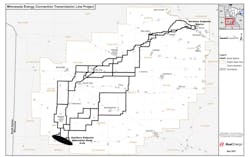Xcel Energy Proposes Routes for 345 kV Minnesota Energy Connection
Minnesota state regulators received proposed route options for Xcel Energy’s 175-mile-long Minnesota Energy Connection, a planned transmission project that would link customers in the southwest part of the state to more renewable power.
The 345 kV, double-circuit transmission line would link up to 4,000 MW of renewable energy to the grid, replacing electricity generated at the retiring Sherco coal-fired power plant.
The utility filed its certificate of need for the project in 2022. A decision on this filing is expected in early 2024. It must receive approvals for both permits before construction begins. A response on the route permits could arrive in 2025, according to an Xcel Energy fact sheet on the project.
If both the certificate of need and route permit are approved, construction could begin on the transmission line in late 2025 and be completed in late 2027.
The project is expected to represent an infrastructure investment of more than $1 billion for the region and create hundreds of jobs to build the transmission line and associated renewable energy projects. Xcel Energy has requested proposals from renewable energy developers for new energy generation, such as wind turbines, to connect to the transmission line once built.
In its most recent transmission needs study from October 2023, the Department of Energy found that long wait times for interconnection agreements, connection costs and delays in new transmission construction are causing congestion and constraints upon the larger power grid. Specifically, constraints exist in the Midwestern power grid because of increased wind output generation and transmission outages.
The route permit application process requires Xcel Energy to provide at least two route options for the proposed transmission line. The route options in the filing follow existing corridors where possible, such as roads and existing transmission lines, and seek to minimize impacts to land use, agricultural operations, natural resources, cultural and historical sites, and recreational areas, according to an announcement from Xcel Energy.
Project leaders reached out to 150,000 landowners by mail and held several rounds of public open houses in communities along the proposed routes. They received and considered more than 750 individual comments about how different proposed routes would affect the area.
About the Author
Jeff Postelwait
Managing Editor
Jeff Postelwait is a writer and editor with a background in newspapers and online editing who has been writing about the electric utility industry since 2008. Jeff is senior editor for T&D World magazine and sits on the advisory board of the T&D World Conference and Exhibition. Utility Products, Power Engineering, Powergrid International and Electric Light & Power are some of the other publications in which Jeff's work has been featured. Jeff received his degree in journalism news editing from Oklahoma State University and currently operates out of Oregon.
